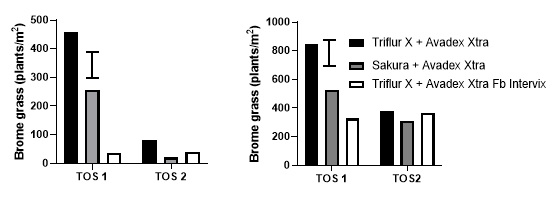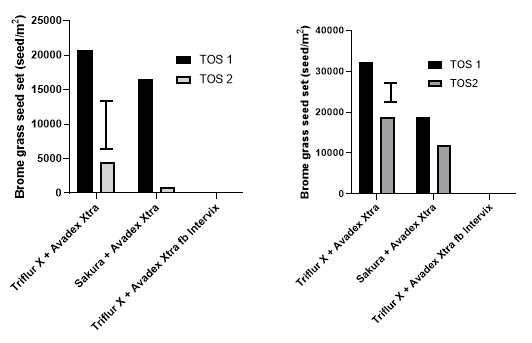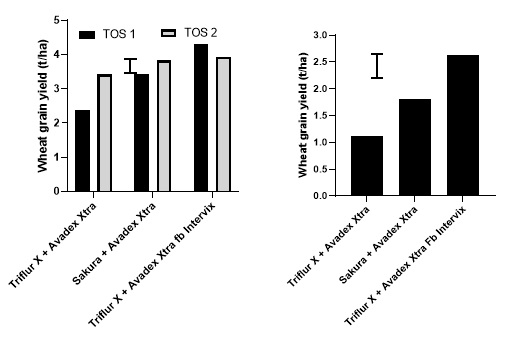Integration of non-chemical tactics to improve brome grass management
Integration of non-chemical tactics to improve brome grass management
Author: Gurjeet Gill and Ben Fleet (University of Adelaide) | Date: 09 Feb 2021
Take home messages
- The response of weed density to delayed sowing is influenced by not only the weather conditions, but also by the seed dormancy attributes of the weed populations. Less dormant weed populations tend to emerge quickly after the opening rains and they can be managed well by moderate delays in sowing. Conversely, high dormancy populations emerge more slowly and a delay in sowing tends to be less effective on such populations.
- At Riverton, a two-week delay in wheat sowing reduced in-crop brome grass density by 82% as compared to a 39% reduction at Mallala. As both sites received very similar rainfall in May, these large differences in brome grass establishment are likely to be associated with seed dormancy in these populations.
- Sakura® + Avadex® Xtra provided superior brome grass control than TriflurX® + Avadex® Xtra in the early sown wheat at both sites. However, follow-up post-emergent application of the imidazolinone (IMI) herbicide, Intervix® provided the best control of brome grass.
- At Riverton, there was a 9% yield penalty for the two-week delay in sowing. It is not possible to estimate the yield penalty from delayed sowing at Mallala due to severe frost damage to the crop in the first time of sowing.
Background
Weed infestations in Australia are responsible for large annual expenditures ($2.5 billion) and yield revenue losses ($745 million) for grain growers (Llewellyn et al. 2016). Annual ryegrass has maintained its number one ranking as the worst weed of Australian cropping systems for many years. However, brome grass has increased in importance and has climbed to be the fourth worst weed in terms of the area infested, as well as yield and revenue loss in grain crops in Australia (Llewellyn et al. 2016).
Brome grass tends to be difficult to control effectively with the pre-emergent herbicides that are registered for use in cereal crops. Even herbicides such as Sakura® are moderately effective and only provide weed suppression. On the positive side, evolution of herbicide resistance in brome grass has been relatively slow in comparison with ryegrass. Development of Clearfield® herbicide tolerant varieties still provides an excellent opportunity for the control of brome grass in cereal crops. Some growers are reluctant to grow Clearfield® crops due to the risk of carryover of herbicide residues into the next growing season. However, this technology appears to be the standout option at this stage for the control of brome grass in wheat and barley.
Previous research on non-chemical tactics for weed control has shown significant benefits of higher wheat seeding rates for the suppression of ryegrass (e.g. Lemerle et al. 2004). Higher crop seeding rates can be easily integrated into weed control programs. Furthermore, adoption of precision agriculture technology allows growers to apply higher seeding rates only to the weediest parts of the paddock, thereby reducing the cost of weed management. Delay in crop sowing has also been suggested as a tactic for the management of dense weed infestations by allowing more time for weeds to germinate and establish prior to crop sowing. However, delayed sowing is often associated with lower crop yields, especially in the low to medium rainfall environments. Additionally, the effectiveness of delayed crop sowing is highly dependent on the rainfall received during the seeding delay and also on the seed dormancy of the target weed population. Gill and Kleemann (2013) showed that brome grass populations from cropping fields in the mid north of South Australia (SA) and Victorian Mallee regions had much longer seed dormancy than those from non-cropped habitats. This adaptation mechanism facilitates avoidance of pre-sowing weed control practices. Furthermore, research undertaken in this project has shown that the benefits of improved pre-sowing weed control by delayed sowing can be completely nullified in some weed populations by reduced competitiveness of late sown crops.
Field trials were undertaken in this GRDC investment, to investigate the effects of integrating crop sowing time, seeding rate and herbicide tactics on brome grass management. Results are presented for two field trials undertaken in 2019 to highlight the impact of these management tactics on brome grass control.
Method
Two replicated field trials were undertaken in SA in 2019 to investigate brome grass management in Razor Cl Plus Clearfield® wheat.
Table 1. Management information for brome grass trials undertaken in 2019.
Detail | Mallala | Riverton |
|---|---|---|
Crop (variety) | Wheat (Razor CL Plus) | Wheat (Razor Cl Plus) |
Sowing date | TOS 1: 16 May 2019 TOS 2: 31 May 2019 | TOS 1: 16 May 2019 TOS 2: 31 May 2019 |
Crop seed rate | 100, 150 or 200 seeds/m2 | 100, 150 or 200 seeds/m2 |
Herbicides | 1. TriflurX 2L/ha + Avadex Xtra 2L/ha 2. Sakura 118 g/ha + Avadex Xtra 2L/ha IBS 3. TriflurX 2L/ha + Avadex Xtra 2L/ha fb Intervix 750mL/ha post | 1. TriflurX 2L/ha + Avadex Xtra 2L/ha 2. Sakura 118 g/ha + Avadex Xtra 2L/ha IBS 3. TriflurX 2L/ha + Avadex Xtra 2L/ha fb Intervix 750mL/ha GS14 |
Growing season rainfall (mm) | 229 | 267 |
Active ingredients: Sakura = 850 g/kg pyroxasulfone; Avadex Xtra = 500 g/L
triallate; TriflurX = 480 g/L trifluralin; Intervix = 33 g/L imazamox + 15 g/L imazapyr
time of sowing (TOS); incorporated by sowing (IBS); growth stage (GS); followed by (fb)
Results and discussion
Brome grass plant density and seedbank
The average seedbank of brome grass at Mallala was 1863 ± 303 seeds/m2 and 2877 ± 406 seeds/m2 at Riverton. Sowing time had a large influence on brome density at Riverton, with the two-week delay in sowing significantly (P<0.05) reducing in-crop brome grass density by 82% (Figure 1). Even though the reduction in brome density due to the two-week delay in sowing was also significant (P<0.05) at Mallala (38%), its effectiveness was much lower than at Riverton (82% reduction). Both sites received very similar rainfall during the month of May in 2019. Therefore, the difference in brome grass density response to delayed sowing at these two sites is likely to be related to differences in seed dormancy between the populations.
At Riverton there were significant differences between the three herbicide treatments in TOS 1 but not in TOS 2 (Figure 1a). It seems the sowing time was the dominant effect in this trial which meant that the herbicide treatments were statistically similar in TOS 2. However, there were significant differences between the herbicide treatments in TOS 1. The application of the IMI herbicide, Intervix® provided the most effective control of brome grass in both sowing times of wheat.
At Mallala, the TriflurX + Avadex Xtra mixture had a significantly higher brome plant density in TOS 1 than the other herbicide treatments including the mixture of Sakura + Avadex Xtra (Figure 1b). It may seem surprising that TriflurX + Avadex Xtra fb Intervix had more than 300 brome grass plants/m2. However, these plants were very small due to late emergence from the seedbank. Most of these plants died later in the season before the panicle emergence stage (Figure 2b).

Figure 1. The effect of crop sowing time and herbicide treatments on in-crop brome grass plant density at Riverton (a) and Mallala (b). TOS 1 = 16 May and TOS 2 = 31 May. The error bars represent LSD (P=0.05).
Brome grass seed production
When averaged across the wheat seeding rate and herbicide treatments, the two-week delay in seeding reduced brome seed production by 85% at Riverton and 40% at Mallala. This reduction in seed set by delayed sowing is consistent with its effect on brome grass plant density. Wheat seeding rate also had a significant effect on brome seed production. At Mallala, as wheat density increased from 100 seeds/m2 (low) to the highest seed rate (200 seeds/m2 – high) brome seed production was reduced by 42%. These results are consistent with previous findings that higher crop density can be an important part of an integrated weed management program.
At Riverton, the delay in crop sowing by two weeks reduced brome grass seed set by 76% for TriflurX + Avadex Xtra and 93% for Sakura + Avadex Xtra treatments. However, there was no such reduction in brome grass seed set following TriflurX + Avadex Xtra fb Intervix treatment because the treatment prevented brome grass seed set in both times of sowing (Figure 2a). Similar effects of delayed sowing on herbicide efficacy on brome seed set were also observed at Mallala (P=0.026) (Figure 2b). Delayed sowing reduced brome seed set in TriflurX + Avadex Xtra by 42% and in Sakura + Avadex Xtra by 37%. When Intervix (Clearfield technology) was used after pre-emergent TriflurX + Avadex Xtra, it prevented seed set in brome grass (53 seeds/m2 in TOS 1 and 0 seeds/m2 in TOS 2). Sakura + Avadex Xtra provided significantly greater reduction in brome seed set as compared to TriflurX + Avadex Xtra at both sites.

Figure 2. The effect of crop sowing time and herbicide treatments on in-crop brome grass seed production at Riverton (a) and Mallala (b). TOS 1 = 16 May and TOS 2 = 31 May. The error bars represent LSD (P=0.05).
Wheat grain yield
Wheat grain yield at Riverton ranged from 1.43t/ha to 4.47t/ha with a site mean yield of 3.55t/ha. Wheat grain yield was significantly influenced by wheat seed rate (P=0.014), with the highest seed rate yielding 14% higher than the lowest seed rate. Herbicide treatment had a significant effect on wheat grain yield (P<0.001). The interaction between TOS and herbicide treatment also had a significant effect on wheat grain yield (P<0.001). In TOS 1, when Intervix (POST) was applied after TriflurX +Avadex Xtra IBS (2.391t/ha), wheat grain yield increased by 45% to 4.32t/ha (Figure 3a). The comparison of the same treatments in TOS 2 showed only 15% increase in wheat grain yield from 3.42t/ha to 3.93t/ha. The large difference in brome grass plant density in TriflurX +Avadex Xtra IBS between TOS 1 and TOS 2 (Figure 2) is the most likely reason for these yield responses. Unlike TOS 1, TOS 2 did not have any significant difference in wheat yield between herbicide treatments as brome grass was effectively controlled by the knockdown herbicide due to the low seed dormancy in this brome grass population. As brome grass was almost completely controlled in TriflurX + Avadex Xtra fb Intervix (Figure 2), comparison of TOS 1 and TOS 2 for this treatment provides an indication of the yield penalty from delayed sowing. The wheat yield for this herbicide treatment was 4.32t/ha for TOS 1 as compared to 3.93t/ha for TOS 2, which equates to 9% yield penalty (Figure 3) or 130kg/ha/week.
Wheat grain yield at Mallala in 2019 was significantly influenced by the time of sowing (P=0.002), seed rate (P=0.043) and the herbicide treatments (P<0.001) (Figure 3b). When averaged across herbicide and seed rate treatments, wheat grain yield was only 1.17t/ha in TOS 1 as compared to 2.54t/ha in TOS 2, which was sown two weeks later. Unfortunately, there were several severe frost events at Mallala during the spring of 2019 which severely reduced wheat yield in TOS 1. There were three days of <0oC at Mallala, which indicates a severe frost risk. Wheat grain yield increased consistently with the increase in seed rate or crop density. This trend correlates well with the improved suppression of brome grass panicle density and seed set observed in the trial. Not only did higher wheat density achieve superior weed suppression, it also provided a significant increase in grain yield.

Figure 3. The effect of crop sowing time and herbicide treatments on wheat grain yield at Riverton (a) and effect of herbicide treatments on wheat yield at Mallala (b). As there was no interaction between herbicides and sowing time, average yield of the two sowing times is presented for Mallala. TOS 1 = 16 May and TOS 2 = 31 May. The error bars represent LSD (P=0.05).
Herbicide treatments had a significant effect on wheat grain yield at Mallala (Figure 3b). This was expected considering the high weed density present at the site and the high competitive ability of brome grass. The treatment of TriflurX + Avadex Xtra produced a wheat yield of only 1.11t/ha, which was significantly lower than the wheat yield produced following the more expensive pre-emergent herbicide mixture of Sakura + Avadex Xtra (1.81t/ha). However, when Intervix post-emergence herbicide was used, wheat yield increased further to 2.63t/ha. In this trial, integration of Clearfield® technology with pre-emergent herbicides not only prevented brome grass seed set (Figure 2b), it also produced the highest grain yields (Figure 3b).
Acknowledgements
The research undertaken in this project was made possible by the significant contributions of growers through both trial cooperation and the support of the GRDC, the authors would like to thank them for their continued support.
References
Gill, G.S. and Kleemann, S.G.L. (2013) Seed dormancy and seedling emergence in ripgut brome (Bromus diandrus) populations in southern Australia. Weed Science 61, 222-229.
Llewellyn, R.S., Ronning, D., Ouzman, J., Walker, S., Mayfield, A. and Clarke, M. (2016) Impact of weeds on Australian grain production: the cost of weeds to Australian grain growers and the adoption of weed management and tillage practices. Report for GRDC. CSIRO, Australia.
Lemerle, D., Cousens, R.D., Gill, G.S., Peltzer, S.J., Moerkerk, M., Murphy, C.E., Collins, D., and Cullis, B.R. (2002) Reliability of higher seeding rates of wheat for increased competitiveness with weeds in low rainfall environments. Journal of Agricultural Science 142, 395-409.
Contact details
Dr Gurjeet Gill
Waite Campus, The University of Adelaide, Glen Osmond, SA 5064
(08) 8313 7744
gurjeet.gill@adelaide.edu.au
Varieties displaying this symbol beside them are protected under the Plant Breeders Rights Act 1994
GRDC Project Code: UOA1711-005RTX,
Was this page helpful?
YOUR FEEDBACK
